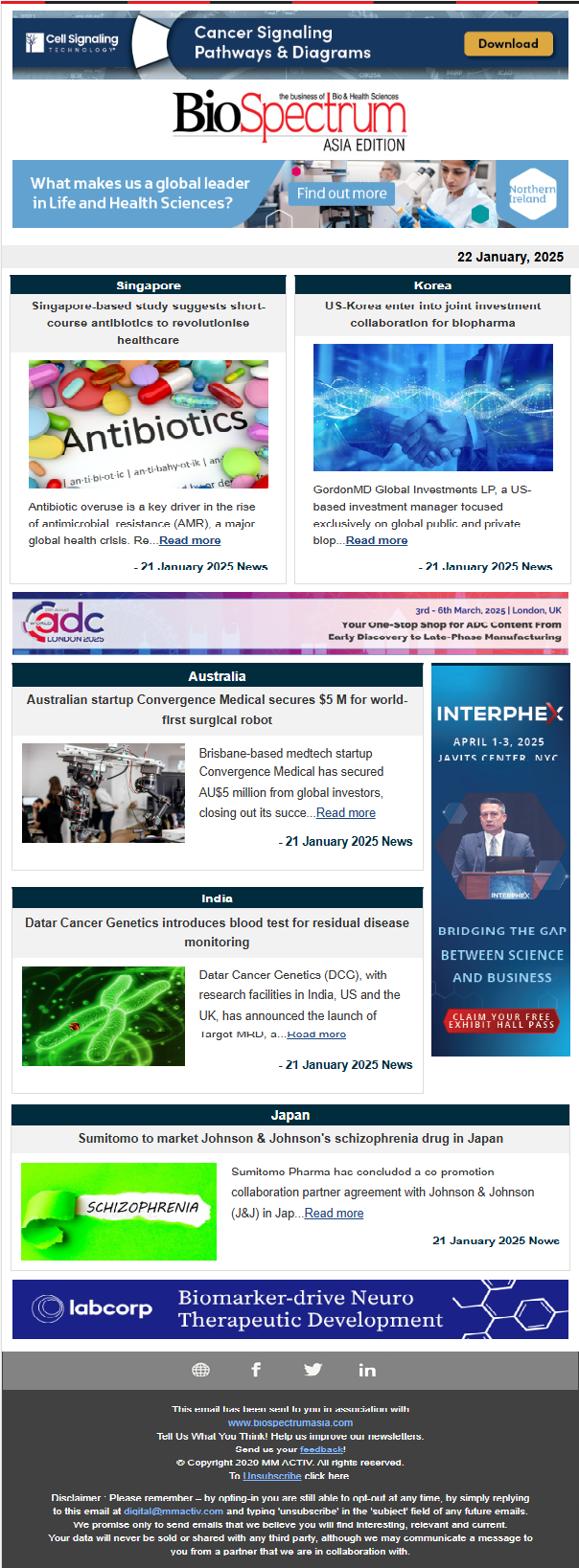
image credit- shutterstock
Biotech partnerships of APAC differ in a variety of ways from most global collaborations, primarily due to the unique geopolitical and socio-economic landscape of the region. The region has innovation hubs like Japan and South Korea as well as large, high-growth markets such as China and India. As China rapidly scales its biopharma capabilities, it is becoming both a key market and an innovator. This transformation has redefined regional deal-making, shifting the focus from technology transfer to co-development, shared commercialisation, and strategic alignment. APAC biotech deals are no longer early-stage R&D plays, they are beginning to span the full lifecycle, from bench to bedside, including commercialisation milestones. Let’s explore further the APAC's wave of regional biotech partnerships during the first five months of this calendar year i.e. from January to May 2025.
In the first half of 2025, up to May 20, the APAC biotech industry has seen a surge in regional partnerships. A total of 24 partnerships have been recorded so far, spanning areas such as antibody-drug conjugates (ADCs), digital health, contract development and manufacturing (CDMO), AI-driven diagnostics, and gene therapy.
China, of course, stands out as the region’s most prolific participant in these partnerships. Chinese firms are involved in over half of the collaborations recorded during this period, particularly in areas like ADCs, CDMO services, AI-powered diagnostics, and imaging systems. Companies such as WuXi XDC, Minghui Pharmaceutical, Belief BioMed, and United Imaging exemplify how Chinese biotech and medtech companies are forming both domestic and cross-border alliances to consolidate their leadership in innovation and manufacturing.
South Korea is another key driver of regional partnerships. Korean companies are heavily represented in deals involving new cutting-edge therapies like exosome-based injectables, CAR-T and CAR-NK immunotherapies, and AI-enabled healthcare workflows. Korean players are also frequently aligning with Chinese companies for ADC development, as seen in DAAN Biotherapeutics’ deals with both LigaChem and GC Cell.
Singapore, while smaller in biotech output, plays a strategic role as an innovation and research hub. Its institutions, like A*STAR and Duke-NUS Medical School are actively engaged in transferring intellectual property to startups and biotech ventures through licensing deals. Partnerships such as the one between Engine Biosciences and the Experimental Drug Development Centre demonstrate how Singapore is leveraging its scientific base to generate regionally relevant IP for precision oncology and synthetic biology.
Taiwan’s activity is most visible in medtech and diagnostics, with companies like Brain Navi and NEWCL forming cross-border alliances. Meanwhile, Vietnam and Malaysia are beginning to make their presence felt, especially in diagnostics and commercial distribution. Vietnam’s Gene Solutions, for instance, has partnered with Taiwan’s NEWCL to expand access to its non-invasive prenatal testing (NIPT) and oncology diagnostics portfolio across the region.
India too has taken a strategic approach by expanding its commercialisation footprint. Cipla’s deal with Taiwan’s Formosa grants it rights to market ocular drugs in 11 countries, from South Asia to Latin America and Africa. Dr. Reddy’s partnership with China’s Henlius Biotech is another example where Indian pharma is leveraging regional innovation to access large global markets, including the US and Europe.
Let’s look at some of the other trends:
ADC boom
From a thematic perspective, ADC development is by far the most prominent focus area across the region. Several Korean and Chinese companies are aligning to integrate proprietary ADC platforms with end-to-end development and manufacturing capabilities. This growing interest points to Asia’s ambitions to become a global centre for ADC innovation, reducing historical reliance on Western technologies in this complex therapeutic class. The number of deals focused on CDMO and ADCs has surged, underlining two key priorities: accelerating product pipelines and expanding biomanufacturing capabilities within the region.
Examples:
These reflect Asia-Pacific’s ambition to become not just a consumer of biologics but a global supplier of advanced therapies.
Digital Health and AI
Digital health and artificial intelligence (AI)-enabled diagnostics form the second major category of collaboration. Chinese and Korean firms are actively embedding AI into healthcare solutions, from lung cancer screening to neurosurgical robotics and health cloud platforms. These partnerships reflect an emphasis not only on technology development but also on large-scale deployment in hospitals and national screening programmes.
Examples:
These cases indicate the region’s desire to leapfrog traditional infrastructure gaps by investing in digital-first healthcare systems and drug development tools.
IP licensing and platform sharing
Licensing deals, especially between academia and startups or within Asia’s innovation hubs, are accelerating early-stage development pipelines.
Examples:
These reflect regional R&D alignment, especially in Singapore, Korea, and Japan- regions with deep translational research capabilities.
Southeast Asia: An emerging strategic expansion zone
Companies from China, India, and Taiwan are increasingly eyeing Southeast Asia, both as a commercial destination and a strategic R&D base.
Examples:
Intra-national partnerships
Another interesting trend is the rise of intra-national partnerships, especially in China and South Korea. These are not merely consolidations within domestic markets, they’re mechanisms to integrate R&D and manufacturing more efficiently and to fast-track clinical development. However, when firms do look to cross-border, it is often for two reasons: to access new markets (as seen in the MediThinQ–Sinopharm deal for distribution in China) or to augment technical capabilities (as in the WuXi XDC–AbTis collaboration for conjugation platform integration).
Strategic drivers
APAC is a densely packed landscape with over 30 countries and around 60 per cent of the total global population. This expanse of countries brings with it a diverse spectrum of systems to navigate, ranging from culture and language to infrastructure, accessibility and regulation. Entering this market successfully requires extensive knowledge of these fragments. This informs the basis for how partnership strategies and their structures in this region are built.
“Strategically, the goals of regional APAC biotech partnerships would be to maximise the opportunities and returns with a commercial partner with proven expertise in the region across the entire value chain – including regulatory capabilities, market access, distribution infrastructure, customer and KOL relationships, sales and marketing capabilities and alliance partnership management. Successful APAC biotech partnership leverages the strength of the regional partner to achieve targeted market entry and sustainable growth, within specific countries in the region. This often involves addressing prevalent yet unmet medical needs, adapting products to suit local infrastructure and patient affordability, as well as navigating local regulatory landscapes,” said Bijay Singh, DKSH's Global Head, Healthcare Business Unit, Thailand.
This differing strategy extends to how it is implemented in terms of structure. Biotech partnerships in APAC tend to be tailored when compared with partnerships built on the global level as they must account for a wide range of differing factors such as the aforementioned regulations or infrastructure.
“These partnerships often focus on the effective integration of local operational capabilities and expertise held by market expansion service providers such as DKSH Healthcare. This can address specific in-country regulatory landscape, supply chain complexities, and go-to-market strategies, which can vary significantly from one APAC nation to another. Additionally phased approaches are often implemented, that way companies can focus on its expansion to one APAC market at a time. For wider APAC plans, firms may also choose a stable central hub like Singapore to manage regional activities.,” added Singh.
The APAC region has long stood as a dual force in global biopharma—home to deep innovation in countries like Japan and South Korea, and massive, fast-growing markets in China and India.
“In the recent decade, as China is keeping up its biopharma innovation, the dynamics and landscape of the APAC and global biopharma market have been drastically impacted by the size of capital and talent invested in biopharma innovation, as well as the market growth due to the fast-growing GDP. Therefore, the innovation in Japan and Korea has a second choice to partner with Chinese companies to access the huge market in China. And the innovation originated from China could also partner with Japan and Korea biopharma companies to co-develop into global products,” said Leo Lyu, Director of Marketing, Chime Biologics, China.
As China cements its dual role as both a biopharma innovator and a massive commercial market, regional deal-making strategies are evolving to reflect a new calculus of risk and opportunity.
"Given China's growing influence in biopharma innovation and market scale, companies across the APAC region are increasingly structuring partnerships with milestone-based terms, particularly in the later phases such as commercialisation. These deals often aim to serve global markets like the US and Europe, as well as the rapidly expanding China/APAC region. The commercial potential in China helps balance the risks inherent in innovation, prompting continuous shifts in deal structures as China rises in the global biopharma landscape," added Lyu.
It is also a well-known fact that most innovative therapies have emerged from university laboratories. In the APAC region, this has given rise to regional biotech partnerships that thrive on close university-industry collaboration, tailored to local health needs. These collaborations foster innovation clusters that accelerate research translation and strengthen the region’s competitive edge.
“Regional biotech collaborations in APAC are uniquely shaped by the region’s economic, cultural and innovation landscapes. Unlike global partnerships, which involve broader consortia and complex governance, APAC collaborations focus on targeted alliances between universities and local biotech companies. These partnerships leverage complementary expertise to address region-specific health challenges, such as cancer therapies adapted to local genetic profiles. By emphasising the rapid translation of research into practical applications and nurturing local talent, these regional efforts not only shorten innovation cycles but also build a robust ecosystem that enhances the region’s standing in the global biotech industry,” said Prof. Christopher CHAO, Vice President (Research and Innovation) of The Hong Kong Polytechnic University.
“But translating innovation into impact requires more than just research collaboration; it demands a deep understanding of how healthcare is practised across the region. Healthcare policies and clinical workflows vary significantly from country to country, and this diversity directly influences how partnerships are structured”, said Ed Deng, Co-founder and CEO of Health2Sync, Taiwan. He added, “Our approach is to localise solutions deeply to align with each market’s healthcare practices and patient needs. This allows us to serve as a strategic bridge, enabling both global headquarters and local affiliates of pharmaceutical companies to meet their respective objectives. Whether adapting digital therapeutics to local reimbursement models or integrating with national health data systems, the focus is on creating value on the ground and ultimately improving outcomes.”
While global partnerships remain important, APAC-based partnerships are increasingly viewed as faster, more culturally aligned, and better suited to local regulatory and market conditions. These partnerships are poised to grow and further reshape the region’s biotech landscape.
Ayesha Siddiqui



